These cute socks were knit using Peach 6751 from the original Opal Sweet & Spicy. I really love the colour combination of the peachy orange with the graduating tones of grey.
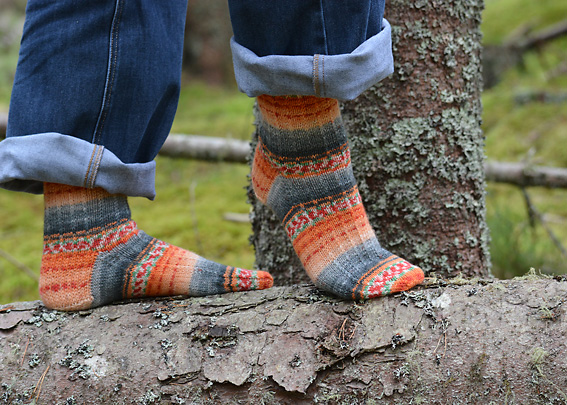
The socks knit up very quickly because of the slip stitch pattern. You very quickly get into a rhythm, slipping every 4th stitch.
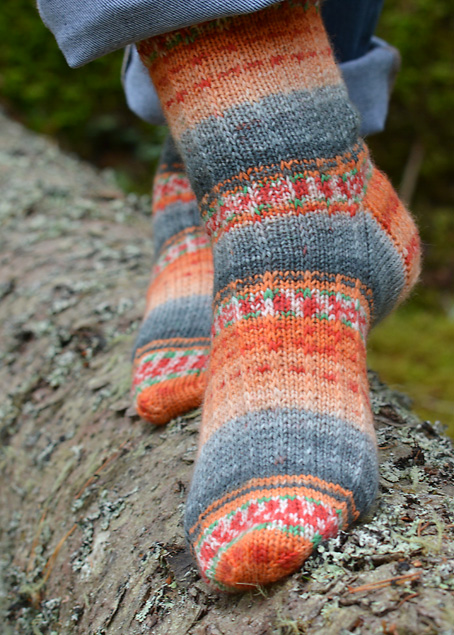
Needles:
- 3.25 mm (US 3) double pointed needle (dpn) for casting on
- 2.75 mm (US 2) (set of 5) clover takumi bamboo double pointed needles for knitting socks
- tapestry needle for sewing in ends.
Sock Yarn:
1 x 100g ball of Sock Yarn
Tension:
The tension for these socks is 10 rows and 8 stitches / 2.5cm (1 inch) in stocking stitch (stockinette).
The tension on the slipped stitch pattern is 13 rows (6.5 slipped stitches) and 8.5 stitches = 2.5cm (1 inch).
Slip Stitch Pattern:
- Round 1: k3, slip 1. (repeats over 4 stitches)
- Round 2: k
Abbreviations:
double pointed needle(s) – dpn(s); stitch(es) – st(s); knit – k; purl – p; slip slip knit – ssk; purl two stitches together – p2tog; knit stitch through the back loop – ktbl; slip one stitch – sl1.
Sock Size:
These socks were designed to fit Shoe Size UK 5 to 6, EU 38 to 39 and US 7 to 8. The finished length of the sock from heel to toe measures 24cm (9.5″). The 4 stitch repeat of this stitch pattern means it is easy to make the sock bigger or smaller by casting on more or less stitches, making sure the number is divisible by 4.
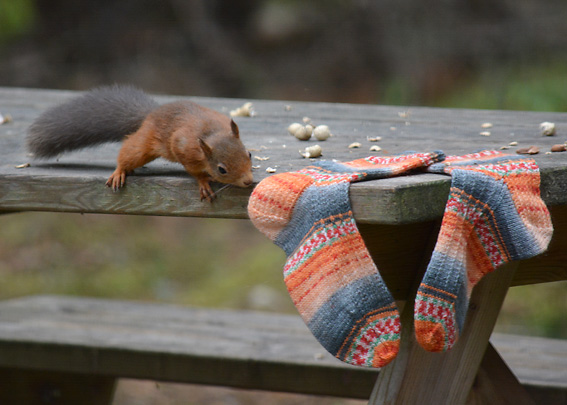
Cuff:
I cast on 64 stitches instead of the normal 60 stitches because the tension for the slip stitch pattern is a little bit tighter.
- Cast on 64 stitches using 3.25mm double pointed needle using the long tail cast on or your favourite stretchy cast on.
- Join into the round as you rib the first round using 2.75m double pointed needles. 16 stitches on each needle.
- Work k1, p1 rib for 14 rounds.
Leg:
- Round 1: k2, sl1, *k3, sl1; repeat from * to last stitch, k1.
- Round 2: k
- Repeat rounds 1 and 2 for a total of 52 rounds.
These socks have a shorter leg than I would normally knit. But I decided that I wanted to stop knitting after I finished knitting green, white and red stripe. I wanted the heel to be knit using the peachy orange colour. The leg of my sock measured 13cm (5.25″) from the top of the cuff to where I started the heel. You may wish to knit a longer leg section.
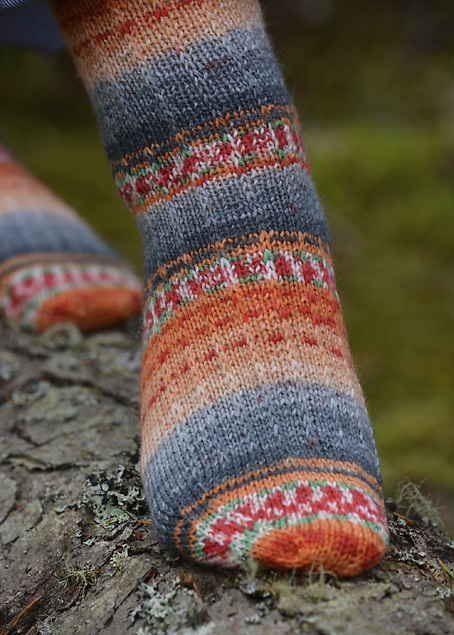
Heel:
After finishing the leg section:
- Row: Sl1, k1 across needle 1, then sl1, k1 across needle 2, then slip one stitch from needle 3 onto needle 2, turn.
- Working the heel flap across 33 stitches.
- Row 2: purl across needle 2 and needle 1 placing all the stitches onto one needle.
- Row 3: *sl1, k1; repeat from * to last stitch, sl1
- Row 4: p
- Repeat rows 3 and 4 twelve more times, then row 3 once more.
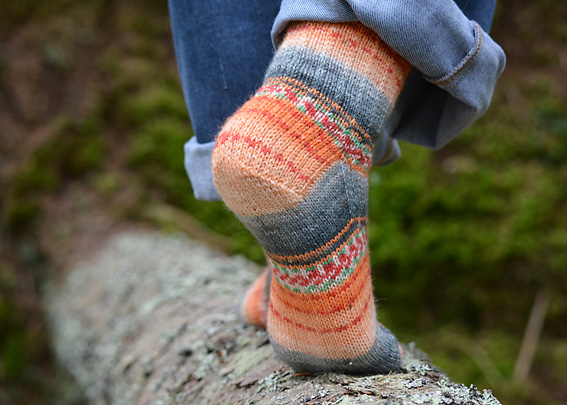
Turn Heel:
- Row 1: p19, p2tog, p1, turn.
- Row 2: sl 1, k6, ssk, k1, turn.
- Row 3: sl 1, p to 1 st before the ‘gap’, p2tog (combines 1 st before the ‘gap’ and 1 st after the gap), p1, turn.
- Row 4: sl 1, k to 1 st before the gap, ssk, k1, turn.
- Repeat rows 3 & 4 until all heel stitches have been worked and 19 sts remain.
Gusset:
Arranging the stitches for knitting the gusset:
Needle 1: Pick up and knit 15 sts along the edge of the heel flap. Needles 2 and 3 (31 instep stitches): k1, sl1, *k3, sl1, repeat from * until one instep stitch remains, k1. Needle 4: Pick up and knit 15 sts along the edge of the heel flap. Then knit across 9 sts from turning the heel. The centre back is now the starting point for the following rounds.
Before you start the next round, slip the other 10 heel stitches onto needle 1.
On next round k10 sts, then ktbl 15 sts, k31, ktbl 15 sts, k9 sts. This prevents any small holes or gaps showing along the edge of the heel flap.
Next round: k25, k1, sl1, *k3, sl1, repeat from * until one instep stitch remains, k1, k24.
Now you are ready to start the gusset shaping.
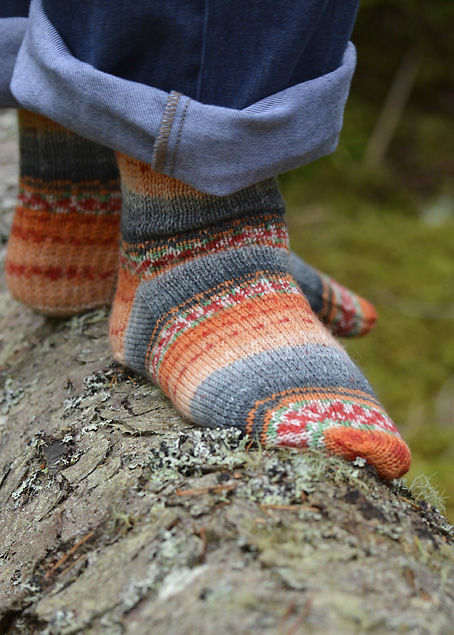
Gusset Shaping:
- Round 1: Needle 1: k to last 3 sts, k2tog, k1; Needles 2 and 3: k31; Needle 4: k1, ssk, k to end of needle.
- Round 2: Needle 1: knit; Needles 2 and 3: k1, sl1, *k3, sl1, repeat from * until one instep stitch remains, k1; Needle 4: knit.
- Repeat rounds 1 and 2 (ending with a round 2) until: Needle 1 has 17 sts; Needle 2 has 15 sts; Needle 3 has 16 sts; Needle 4 has 16 sts. Rearrange stitches so that there are 16 stitches on each needle. Total number of stitches 64.
Foot:
- Round 1: k
- Round 2: k16, k1, sl1, *k3, sl1, repeat from * until one instep stitch remains, k1, k16
- Repeat rounds 1 and 2 for a 42 more rounds. (Total of 44 rounds).
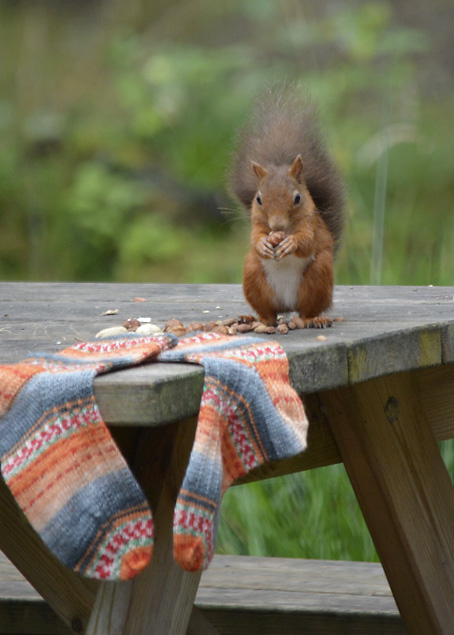
Classic Toe:
The classic toe is all knit in stocking stitch.
- Round 1: Needles 1 and 3: k to last 3 sts, k2tog, k1; Needles 2 and 4: k1, ssk, k to end of needle.
- Round 2: k
- Repeat rounds 1 and 2 until you have 28 sts left.
- Then repeat round 1 until there are 16 sts remaining.
- Making sure that the toe stitches align horizontally with the heel, slip the stitches from needle 4 onto needle 1 and the stitches from needle 3 onto needle 2.
- Graft the toe stitches using Kitchener Stitch.
Please note that the toe is a perfect classic toe – it is not out of shape at all – although sometimes it does look a little skewed in the photos. This is only because I was balancing on a dead tree trunk at the time and couldn’t easily check that my toes were looking perfect and the bark was kind of catching on the soles! But it was a very photogenic tree trunk!!
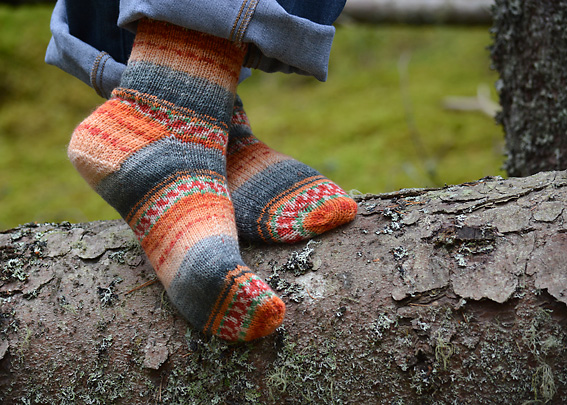
Finishing:
Weave in all loose ends.
I love hearing how you enjoy knitting the sock patterns. Look forward to reading your comments here and on our Facebook page.
The Knitting Squirrel now has a Ravelry Group and I’d love you to come and join us. The more the merrier!

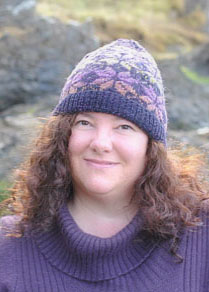
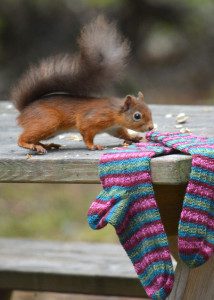
Hi Nicolette,
I really love the colors of the Opal Sweet and Spicy Peach yarn! You did a great job on the socks, and the photos are always interesting to see where you are being photographed.
The log was perfect. Are the squirrels always curious about your socks? (The peanuts help)
I divided my last ball of Opal yarn (Alpine Flower) and am on the second sock. I matched the cuff starting point pretty well–used the Long-tail cast on– and am off only about two rounds but will still try to start the heel flap in the same place as the first sock. I do like to knit twin socks when possible.
Do give us some pointers on how to easier match the starting point with our first sock so we can knit twins when we really want to. Getting the tail of the yarn from inside the ball is quite a chore most of the time for me. Any tips?
Thanks for all your great help and ideas. Joyce in Utah
Hi Joyce, The squirrels were very cute and very curious. Never ever attempted any damage!
I’m planning a post on how I match the patterns for early July. Going to work on it in June. I’m deciding upon which yarn to use for it. Nicolette
Thank you for your helpful advice
You are welcome.
I love your socks but what is your secret for getting the varigated wools to match do you work with two balls of wool.
Hi Barbara,
I used to divide my ball of yarn into two, but now I don’t tend to do that, mainly because I prefer the leftover yarn to be in one ball rather than being divided into 2 small balls.
Opal is helpful because they usually show a photo on the ball band which shows how the yarn will look when it is knitted up into a sock. I normally look at this, pull out the yarn end from inside the ball of yarn, (I always knit from the yarn end from inside the ball), and I will pull the yarn out until I come to the first obvious change in colour. I usually like this to be at the start of one of the wider stripes.
On the Sweet and Spicy Peach socks the point I chose to make the slip knot was at the changeover between the mid grey and the dark grey. I use a long tail cast on so I need to make sure I will have enough of a yarn tail to cast on the stitches. I’m also choosing a point where it will be easy to find the same place for casting on the second sock. I always write down what point the transition point was between the two colours in my notebook. The other thing I do, is that as soon as I finish knitting the first sock, I find the right position in the yarn to cast on the second sock. I always cast on and knit the rib of the second sock as soon as I’ve finished the toe on the first. I don’t necessarily knit the second sock right away, as I always have several different socks on the go at the same time.
I always try to finish at the end of a pattern stripe before I start knitting the heel on the sock. I make a note of this in my notebook too. Sometimes, it doesn’t happen very often, but sometimes I have to knit an extra round on the leg or change the starting point of the round, to make sure that I’m starting the heel in the same place in the yarn pattern as on the first sock.
Some of the yarns like this one, have a long pattern repeat, and I try to choose a point to cast on as soon as I can, because I don’t like wasting yarn. I don’t bother trying to match up the socks when I’m knitting with the Regia Arne & Carlos sock yarn. I love their yarn but they create a very very long pattern repeat, you can knit the whole leg without starting the second repeat of the pattern, so I just make a pair of fraternal socks with them rather than a matching pair.
This has turned into a long reply. I think I’ll take photographs with the next pair of socks I’m knitting, and write a post about this.
In the meantime I hope this helps, Nicolette